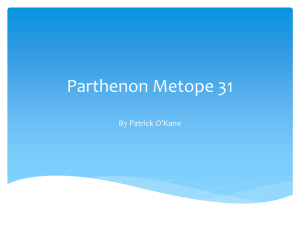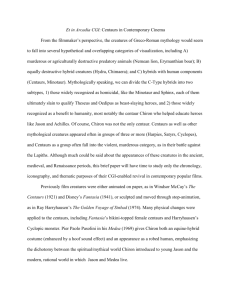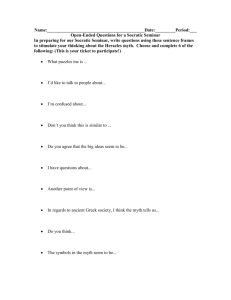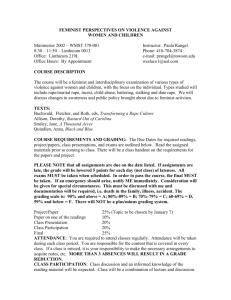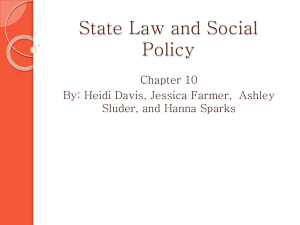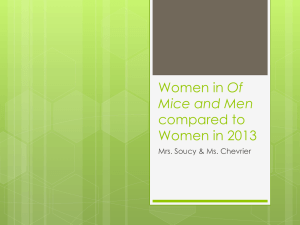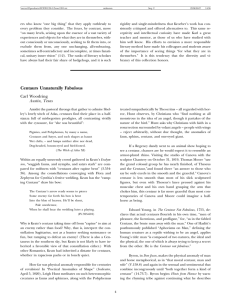Centaurs. A violent masculine myth∗
advertisement
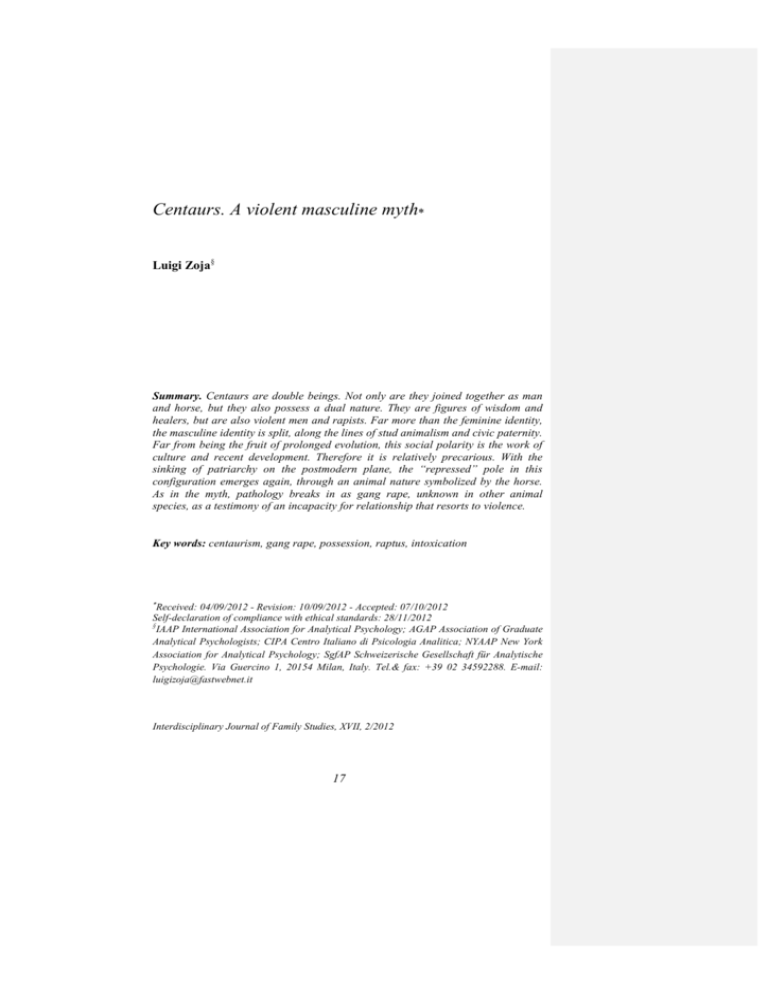
Centaurs. A violent masculine myth∗ Luigi Zoja§ Summary. Centaurs are double beings. Not only are they joined together as man and horse, but they also possess a dual nature. They are figures of wisdom and healers, but are also violent men and rapists. Far more than the feminine identity, the masculine identity is split, along the lines of stud animalism and civic paternity. Far from being the fruit of prolonged evolution, this social polarity is the work of culture and recent development. Therefore it is relatively precarious. With the sinking of patriarchy on the postmodern plane, the “repressed” pole in this configuration emerges again, through an animal nature symbolized by the horse. As in the myth, pathology breaks in as gang rape, unknown in other animal species, as a testimony of an incapacity for relationship that resorts to violence. Key words: centaurism, gang rape, possession, raptus, intoxication ∗ Received: 04/09/2012 - Revision: 10/09/2012 - Accepted: 07/10/2012 Self-declaration of compliance with ethical standards: 28/11/2012 § IAAP International Association for Analytical Psychology; AGAP Association of Graduate Analytical Psychologists; CIPA Centro Italiano di Psicologia Analitica; NYAAP New York Association for Analytical Psychology; SgfAP Schweizerische Gesellschaft für Analytische Psychologie. Via Guercino 1, 20154 Milan, Italy. Tel.& fax: +39 02 34592288. E-mail: luigizoja@fastwebnet.it Interdisciplinary Journal of Family Studies, XVII, 2/2012 17 In modern law and custom, gang rape has always been considered a crime, whereas in the past it was a tolerated exception. The present investigation of the mythical, historical, biological and cultural antecedents of the masculine impulse to rape goes beyond individual pathology. It aims to analyse collective rape and the potential model of acritical behaviour that it embodies. This is different from the behaviour of the individual male, who is more or less aware that he is pathological and that he risks a more or less severe punishment. One would expect gang rape to be an increasingly rare occurrence. But in fact it returned in an uncontrolled form in the Second World War, and since then seems to have become a recurrent epidemic on the margins of former colonies of western nations. Collective rape is not a mere accumulation of individual rapes: the pathological personality of the individual rapist is aware of the crime it is committing and tries to conceal it, whereas gang rape involves a collective orgiastic syndrome which represses or eliminates guilt feelings. Anyone who decides not to join in is mocked and regarded with suspicion, and may feel as if he is abnormal (Sémelin, 2005). Gang rape appears in the modern age of the classical myth: that of the centaurs. To a centaur there was no difference between sexual life and sexual violence; in his eyes rape was the only true form of sexuality. Nor did he see any distinction between war and orgiastic violence against women; hence today this perverse ecstasy may be termed centaurism. The Greek word centaur means “one who kills – or spears (kentein) – the bull (tauros)” There is also perhaps a link with Latin centuria (group of a hundred men). Thus the etymology of the word confirms the menacing elements that underlie the myth: a regression of masculinity to the animal herd and to the physical strength inherent in numbers. In modern historical cataclysms, man may revert to something much more primitive than man, whereas woman remains a woman of, and in, the modern world. In various historical times, the female identity is characterized by relative stability. The male identity, by contrast, is much more recent; it is linked to society and history, and is therefore more fragile. One of the factors behind the emergence of male dominance may have been the need to deny this precariousness. In the evolutionary scale up to the level of the mammals, females evolve towards an increasingly complex care and upbringing of their young; males merely compete for the right to mate. So on the one hand we see two interlinked roles of mother and educator; on the other, struggle plays the crucial role in defining male relationships and their social position, from one victory to another. 18 Monogamous and relatively stable families, nuclei in which males too take on responsibilities towards their children, did not emerge until the protohumans, our direct ancestors. Hence while in the woman/female, maternal identities coexist in an almost harmonious dialectic, in the man, the father and the male (the animal) are precariously balanced polarities. The civilized father is the result of a cultural evolution rather than a zoological one: he needs a capacity for abstraction and organization that transcends mere nutrition, as well as protection and improvement. His behaviour is the result of controlling certain instincts; it has a ‘castratory’ function. It expresses its prohibitions in the interests of the family, before degenerating into the abuses of patriarchal power. For thousands of years Judaeo-Christian values and patriarchal principles provided confirmation and stability for these two never mutually integrated poles of the father and the competitive male. But in the postmodern world, with the breakdown of the family and its traditional values, the thin crust of civilized western patriarchy is eroded; civilized coexistence disintegrates and we see a re-emergence of the pre-paternal male. This is confirmed by the vast predominance of male psychopathologies: the lawless male is still here, and can destroy the seemingly impregnable fortresses of history in the space of a moment. This is the meaning of the stories of centaurs, on the horizons of our history in society and in Greek myth, where the roots of modern thought lie; where the first true western civilization was formed and patriarchal authority reached its most eminent peak. The opposite pole, that of the animal, pre-civilized male, seemed to have been eclipsed, but in fact had only been repressed. In the background of Homer’s mythical literature the beast’s claws are close and furious; they allude to the instability of the civilized condition, and its links with the realm of instinct. The centaurs lived in Thessaly, the northernmost extremity of Greece, to which myth attempted to exile a lawless world that was so close in time. They were represented as human beings from head to waist, with the body of a horse without its head and neck grafted on below. That the story of the centaurs would end badly was clear from the beginning. The centaurs owed their origin to the most violent and impious of men, Ixion. After burning alive his future father-in-law, Deioneus, Ixion is pardoned by Zeus, who purifies him and grants him immortality and life among the gods. But in the divine palaces Ixion meets Hera and tries to rape her. Hearing of this, Zeus decides to put him to the test, creating a cloud in the image of the goddess. Ixion rapes the cloud and a creature called Centaur is born from his sacrilegious embrace. It was the first creature to have been conceived, as Pindar recalls, without Charis: in the 19 dual absence of grace and the passion of love (Pindar, 1997; Apollodorus, 1921). Erotic raptus and intoxication occasionally appear elsewhere in Greek myth, but only in the centaurs are these two frenzies systematically linked, as a primary form of collective behaviour. The Lapiths, an equally strong and uncontrollable race, ruled by King Pirithous, also lived in Thessaly. When Pirithous married Hippodamia, their neighbours the centaurs were invited to the wedding; one of the centaurs, Eurytion, inebriated by wine and by the bride’s beauty, jumps on her and abducts her. The other centaurs, also drunk, do the same with the Lapith women, turning the banquet into a battlefield, a bloody clash between two peoples. In antiquity, the myth was a clear warning of the danger of regressing to the animal male. Today, too, mingling alcohol and violence is more often a male than a female characteristic. In antiquity it is rare to find female centaurs1 (Ovid, 1986); to the Greeks and Romans the centaurs were an insatiable herd, a menacing horde of rampaging drunkards. But the myth also represents them in conflict with two founding fathers, Theseus and the prototypical hero Heracles. Theseus, a symbol of the law-abiding combatant, is not only the architect of the Lapiths’ victory over the centaurs; he also participates in the battle against the Amazons, and therefore combats the excesses of the female element too. Although he sometimes indulges in the rape of women (Kerenyi, 1958), he is chiefly identified as a just ruler and the mythical founder of Athenian democracy (Thucydides, 2009). As a model of patriarchy, Theseus embodies the civilized father, whereas the centaur, the bull and the Minotaur represent the pre-paternal male. The myth of Heracles, the son of Zeus and Alcmene, takes a similar form. Conceived in one of the many relationships forcibly imposed by Zeus, Heracles is welcomed as a guest by the generous centaur Pholus, who imprudently offers him wine. The smell of the drink attracts other centaurs, who, after drinking the wine, start fighting among themselves and then with Heracles. With his poisoned arrows Heracles unintentionally kills both Chiron, the pedagogue and educator of Achilles and Jason, and Pholus. Once again, the mythological allusion is to the collective symbol of unjust killings, reflecting the difficulty Greek society had in conducting a dialogue with the instincts (the centaurs): Heracles acts in this case by 1 One of these exceptions is Hylonome described in Ovid, Metamorphoses. 20 poisoning and repression, sacrificing Chiron and Pholus, the two most creative elements. The warning is clear: the centaurs’ meta-human power is that of an antideity, an extreme evil capable of annihilating, as we are going to see, even the strongest hero. Just as the god represents the elevation of ecstasy, so the centaur embodies a kind of ‘negative ecstasy’ comprising aggressive drunkenness and rape. This is not a regression to a literally animal stage: rape, which is often described as ‘bestial’, is a form of behaviour typical not of animals, but of men2 (de Waal, 2005). The centaur’s alleged bestiality, however, also acts individually, with the same blind frenzy of the herd. This is clear in Heracles’ encounter with the centaur Nessus, who is acting as ferryman over the River Evenus: according to one version of the myth, Heracles fords the river first, leaving his young bride Deianeira in the centaur’s hands; according to another, Nessus ferries Deianeira across first, leaving Heracles on the bank. In both cases, once the couple is divided, Deianeira feels Nessus’s ‘mad hands’3 (Sophocles, 1955) and cries out desperately to her husband on the other bank. Nessus is killed by an arrow from Heracles’ bow and as he dies feigns penitence. If Heracles’ affections should waver one day, Deianeira need only get him to wear a shirt soaked in the centaur’s blood. Deianeira, moved to pity, collects his blood, believing in the miraculous power of love. Later Heracles goes away and conquers a kingdom, but he also wins the king’s daughter: his victory must be ritually honoured with sacrifices to Zeus. Deianeira thinks this is a propitious occasion for using Nessus’s blood, and steeps his ritual robe in it. The result is well known: Heracles is burned alive by the shirt steeped in the centaur’s blood. On his death he is taken up into Olympus with the other gods; Deianeira, regretting her naiveté, kills herself. Thus the meta-human centaur is capable only of pathologically violent sexuality; his mind cannot separate itself from instinct, just as in his body the man cannot separate himself from the animal. He is an aggressor who destroys even the bond between a couple, and who sows the seeds of metaviolence in the mind. Once sown there, the seeds germinate slowly, as a threat of regression to the psychology of the male herd (the centuria). That 2 According to de Waal, in some primates (such as the bonobo) rape is unheard of, whereas in others (such as the chimpanzee) it is a possible but rare option. The ethologist refers, however, to individual acts of violence, never to collective assaults such as those discussed here. 3 màtaios: impious, reckless 21 is why the centaur’s violence is not identified as a mere animal impulse but is more complex, as in the case of Nessus. It is ‘manipulation’, which includes the perversion of power, a desire to subdue and humiliate the victim, without any redemption or admission of error. The centaur expresses a dormant and almost uneducable primitive instinct, an impulse of the collective unconscious which may recur, in the absence of effective barriers. Another significant example of this is provided by the myth of the foundation of Rome. At the beginning of his Life of Romulus4, Plutarch (1914) gives a propagandistic reconstruction of the capital city’s foundation: faced with a continual influx of colonists and a lack of wives, Romulus proclaims that he has discovered the altar of a god named Consus. He invites some neighbouring peoples to the festivities, in particular the Sabines. At a signal from the king, the Romans carry off the Sabine virgins on their shoulders. According to Plutarch this was an act of necessity, not of avidity; in reality, the Romans’ act of seizing and raping indigenous women institutionalized the idea of the ‘melting-pot’, the fusion of peoples. From the point of view of the victims, another equally emblematic archetype for the subject of our investigation occurs in Ovid’s Metamorphoses (1986). The virgin Caenis, raped by the god Poseidon5, asks the contrite god to prevent this act ever being repeated by turning her into a man. Poseidon agrees and Caenis becomes the warrior Caeneus, invincible and eager for war. The just slogan ‘Never again’, used today by the victims of collective rape, has a pathological precedent in the ‘Caenis syndrome’. The victim pays twice over: first she suffers carnal violence, then she vents her fury not on the male who attacked her but on the female beauty and grace that she considers in some sense responsible for the aggression. Here again we have a case of meta-rape, an unconscious but radical introjection of the criminal male. A pathological reaction which sees femininity as the enemy and, to prevent any further aggression, identifies with the aggressor who perpetrated it. An investigation of the origins of collective rape, which has proved to be in historical terms a psychological epidemic and in society a collective 4 Romulus is the mythical founder of Rome, just as Theseus is the mythical founder of Athens. For this reason Plutarch in his Parallel Lives takes him as Theseus’s parallel. 5 It is interesting to note in the context of the present discussion that, like other rapist gods, Poseidon could turn into an animal to disguise himself or deceive female figures, and that his speciality was changing into a horse. Several myths concerning the centaurs are associated with him. 22 pathology, is not only concerned with a crime. A loss of male identity is the main factor in stimulating gang rape, a phenomenon which jeopardizes the very existence of society. It is a terrible situation which occurs repeatedly, throwing light on mental pathologies in which individuals taken individually contrive to appear sane, but together perform the most unexpected perversions. The few existing studies on the subject stress, at the root of the phenomenon, a rejection of individual responsibility: alongside the abovementioned abuse of alcohol and drugs, frequent factors are economiccultural poverty and the absence of the rule of law and police forces. The main aggravating factor, however, is the state of war rooted in a masculinist, patriarchal culture. Another important instance of collective male violence were the colonial enterprises. What has been described as the American holocaust (Stannard, 1992; Todorov, 1982; Kiernan, 2007), in the central and southern part of the continent, was carried out by male invaders; they killed the indigenous inhabitants and took their women as concubines. Over the centuries little has been learned about collective rape in war because it has not been discussed as a crime in itself. Ever since the fratricide of Cain or the war between the Greeks and Trojans, violence has destroyed men, but at the same time generated words, speeches, tales of bloodshed6 (Homer, 2000). Sexual pillaging, on the other hand, generates silence; it paralyses the mind by putting the stamp of shame on it and dehumanizing both the victim and the aggressor. Gang rape is not only a consequence of war getting out of control, but a ‘programmed’ form of behaviour. Today in particular, it tends, partly unconsciously and partly consciously, to accelerate conquest, and sometimes genocide. It can overturn geography and history, like an immense tidal wave that advances invisibly, a fury that spreads hatred and corrupts the uniting impulse which we call heroes. 6 According to the Odyssey the gods caused the Trojan War to take place so that the story of its fall could be told. 23 References Apollodorus (1921). Bibliotheca: Volume II (J. G. Frazer, Trans.). In Loeb Classical Library (Vol. 121-122). Cambridge, MA: Harvard University Press (Original work published ca. II century AD) de Waal, F. (2005). Our inner ape. New York: Riverhead Books (tr. it. La scimmia che siamo, Garzanti, Milano, 2006) Homer (2000). Odyssey (S. F. Lombardo, Trans.). Indianapolis: Hackett Publishing Company (Original work published ca. 800-700 B.C.) Kerenyi, K. (1958). Die heroen der Griechen [Gods and heroes of Greece]. Zurich: Rhein-Verlag (tr. it. Gli dei e gli eroi della Grecia (Vol. 2), Garzanti, Milano, 1976) Kiernan, B. (2007). Blood and soil: A world history of genocide and extermination from Sparta to Darfur. New Haven, London: Yale University Press Ovid (1986). Metamorphoses (A. D. Melville, Trans.). Oxford: Oxford University Press. (Original work published ca. AD 8) Pindar (1997). Pythian Odes (II) (W. H. Race, Trans.). London: Harvard University Press. (Original work published ca. 475 B.C.) Plutarch (1914). Parallel lives: Volume I. Theseus and Romulus, Lycurgus and Numa, Solon and Publicola (B. Perrin, Trans.). In Loeb Classical Library (Vol. 46). Cambridge, MA: Harvard University Press (Original work published ca. end of I century AD) Sémelin, J. (2005). Purifier et détruire: Usages politiques des massacres et genocides [Purify and Destroy: Political uses of massacre and genocide]. Paris: Le Seuil (tr. it., Purificare e distruggere: Usi politici dei massacri e dei genocidi, Einaudi, Torino, 2007) Sophocles (1955). Trachiniae (R. C. Jebb, Trans). Cambridge: Cambridge University Press (Original work published ca. 438-420 B.C.) Stannard, D. E. (1992). American holocaust: The conquest of the New World. Oxford/New York: Oxford University Press (tr. It. Olocausto americano: La conquista del Nuovo Mondo, Bollati Boringhieri, Torino, 2001) Thucydides (2009). The Peloponnesian war (M. Hammond, Trans.). Oxford/New York: Oxford University Press (Original work published ca. V century B.C.) Todorov, T. (1982). La conquête de l’Amérique: La question de l’autre [The conquest of America: The problem of the other]. Paris: Le Seuil (tr. it. La conquista dell’America: Il problema dell’altro. Einaudi, Torino, 1984) 24
